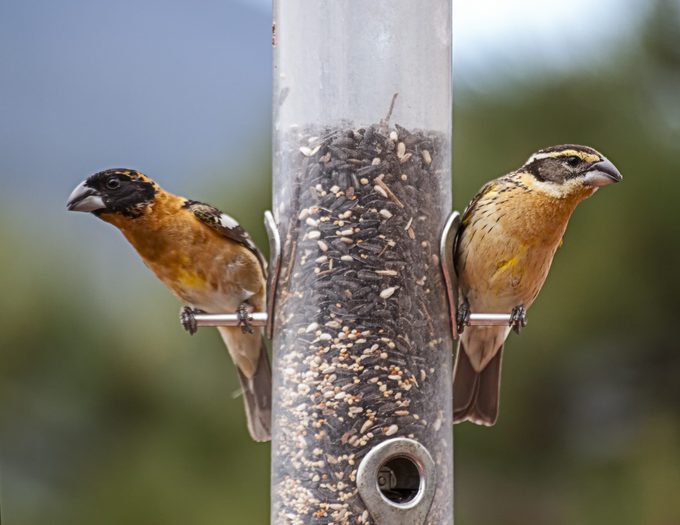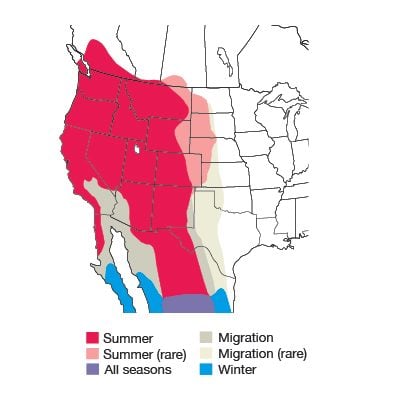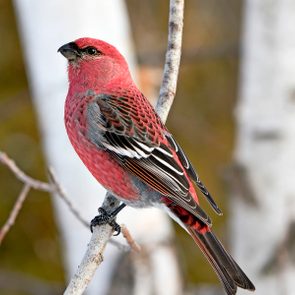How to Identify a Black-Headed Grosbeak
Updated: May 22, 2024
Serve the right kind of food if you want to attract a black-headed grosbeak. Learn what these birds look like and where you can spot one.
On This Page
Male and Female Black-Headed Grosbeak

- Black-headed grosbeak
- Scientific Name: Pheucticus melanocephalus
- Family: cardinal
- Length: 8 inches
- Wingspan: 12-1/2 inches
The males of this species get their distinctive color in their second year. “The male black-headed grosbeaks are fairly straightforward to identify,” says Emma Greig, project leader for the Cornell Lab of Ornithology’s Project FeederWatch. She suggests looking for a rufous-orange chest, bright white wing patch and the black head that is referenced in their name.
“Females and young males are trickier,” Emma says. “Look for their large beak, white eye stripes and warm rusty wash on the breast and flanks.” Black-headed grosbeaks are also on the larger side for songbirds, around 8 inches in length.
Check out the types of grosbeaks backyard birders should know.
Nest and Eggs

It takes a female black-headed grosbeak about four days to build a cup-shaped nest of twigs, grasses and pine needles. But after that, the male pitches in and shares incubation and feeding duties with his mate.
Located in the dense outer foliage of a tree or shrub, the nest is built of natural materials and hair and holds two to five green or blue spotted eggs.
What Do Black-Headed Grosbeaks Eat?

Their strong beaks give them an advantage on breaking through the tough shells of seeds, but they also use them to eat insects such as beetles and grasshoppers. Their beaks are so strong that black-headed grosbeaks have been known to crack open snail shells.
Monarch butterflies’ milkweed diet makes them bitter-tasting and toxic to many predators, but black-headed grosbeaks eat them anyway. These birds strategically wait several days between their monarch snacking sessions to give their bodies enough time to flush out the toxins.
“Attract black-headed grosbeaks to your yard by offering seed in a large feeder such as a hopper or platform feeder,” Emma says. “Black oil sunflower seed is the perfect seed type to give them.” They’re also voracious fruit eaters, even enjoying poison oak berries. Make your yard extra enticing with fruiting trees and bushes such as crabapple, elderberry and raspberry (if you’re willing to share).
Black-Headed Grosbeak Song

A black-headed grosbeak’s song is similar to an American robin’s but at a faster pace. What really makes this species stand out, however, is who is doing the singing.
“Female black-headed grosbeaks actually sing!” says Emma. “Usually the female black-headed grosbeak has a shorter version of the male’s song, but sometimes they can sing a full, male-like song. Perhaps they’re trying to get their mate to pay more attention to them by mimicking the presence of an intruding male.”
Bird songs provided by the Cornell Lab of Ornithology.
Black-Headed Grosbeak Habitat and Range

While the East and Midwest have rose-breasted grosbeaks, head across the Great Plains region and you’ll meet their orange-hued cousins, the black-headed grosbeaks.
If you’re in their range, look for black-headed grosbeaks in deciduous trees and open woodlands, but they’re usually willing to stop by backyards during spring and fall migration.
Black-headed and rose-breasted grosbeaks’ ranges overlap in the Great Plains, and these two species are closely related enough that they sometimes interbreed with each other to create hybrids. These combo birds can end up looking like either parent or a mix between the two.

Range maps provided by Kaufman Field Guides, the official field guide of Birds & Blooms.
About the Expert
Emma Greig is the project leader of Project FeederWatch, a citizen science program, for the Cornell Lab of Ornithology. Emma holds a Ph. D. from the University of Chicago and previously was a postdoctoral associate in Macaulay Library.
Sources
- National Geographic – black-headed grosbeak
- National Audubon Society – black-headed grosbeak
- All About Birds – black-headed grosbeak
- BirdNote
- University of California-Berkeley research
- American Bird Conservancy – grosbeaks of North America
- eBird – rose-breasted grosbeak x black-headed grosbeak hybrid
- The Texas Breeding Bird Atlas – black-headed grosbeak
- Black Hills Audubon Society
- Montana Field Guide – black-headed grosbeak
- Sacramento Audubon Society

























